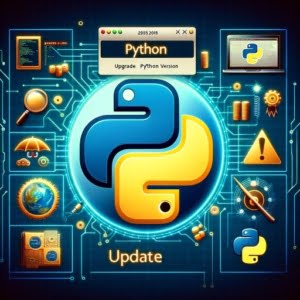Update Python: Step by Step Guide

Updating Python to the latest version is a crucial task we regularly undertake at IOFLOOD to ensure our scripts and applications benefit from the latest features and security patches. Keeping Python up-to-date enhances performance and compatibility, which is essential for our development processes. Today’s article will guide you through the steps to update Python, providing clear instructions to assist our cloud server hosting customers in maintaining a robust and secure development environment.
This guide is designed to provide a comprehensive overview of how to update Python across various operating systems, and the benefits that come with it.
So, whether you’re an experienced Pythonista or a newcomer to the programming world, let’s delve into the realm of Python updates!
TL;DR: How Do I update Python?
Python updates in Ubuntu can be performed by using apt-get.
The command sequence would be:
# Update the package list
sudo apt-get update
# Install Python 3
sudo apt-get install python3
Once installed, Python can be updated at any time by running these commands again. For more detailed instructions, benefits of updating, and how to update Python on different operating systems, read on.
Table of Contents
Updating Python on macOS and Linux
Are you curious about how to update Python on your macOS or Linux system? This section is dedicated to answering that exact question. Let’s begin with macOS.
Updating Python on macOS
For macOS users, one of the most efficient ways to update Python is by using the Homebrew package manager. Homebrew is a free and open-source software package management system that simplifies the installation of software on Apple’s macOS operating system. Here’s a step-by-step guide on how to do it:
# Open Terminal and update Homebrew
brew update
# Upgrade Python
brew upgrade python
After the update, you can check your Python version with the following command:
python --version
Updating Python on Linux
Now, let’s shift our focus to Linux. The method of updating Python on Linux depends on the distribution you are using. Here’s a step-by-step guide for Debian-based distributions like Ubuntu using the Advanced Package Tool (APT):
# Update the package list
sudo apt-get update
# Install Python 3
sudo apt-get install python3
For RPM-based distributions like Fedora, you can use the Yellowdog Updater, Modified (YUM). Here’s a step-by-step guide:
# Update the package list
sudo yum update
# Install Python 3
sudo yum install python3
After the update, you can check your Python version with the following command:
python3 --version
You can also use the ‘update-alternatives’ command to create symbolic links to python3, allowing you to use different versions of Python.
Updating Python on Windows
Shifting our attention to Windows, it’s important to note that, unlike macOS and Linux, Windows doesn’t come with Python pre-installed. So, how do you update Python on Windows? There are several methods you can use, each with its unique advantages. Let’s delve into them.
Using the Official Python Installer
Firstly, there’s the official Python installer from the Python website. This is a straightforward method to install or update Python. Here’s a step-by-step guide:
- Visit the official Python website and Download Python for Windows
- Run the installer, ensure to check the box that says ‘Add Python to PATH’
- Follow the prompts to install Python
- Once installed, verify the installation by opening Command Prompt and typing ‘python –version’
Understanding PIP
Now that you’ve got Python updated, it can be helpful to keep any Python libraries up to date as well. That’s where PIP comes in!
If you’ve been around the Python community, you’ve likely heard the term ‘PIP’. But what exactly is PIP? PIP, an acronym for ‘Pip Installs Packages’, is a package management system used to install and manage software packages written in Python. It’s a tool that simplifies the process of adding, updating, or removing Python packages.
PIP and Dependencies
PIP is instrumental in managing Python-written program packages and their dependencies. Dependencies refer to other packages that a package needs to function correctly. For instance, if you’re using a Python package that depends on a specific version of another package, PIP ensures that the correct version is installed.
You can use PIP to check the dependencies of a package with the following command:
pip show --verbose package-name
PIP and PyPI
But where does PIP source these packages? Enter PyPI, or the Python Package Index. PyPI is a repository of software for the Python programming language. It’s a vast collection of Python packages that PIP can install. When you command PIP to install a package, it fetches the package from PyPI, manages any dependencies, and installs everything for you.
PIP Command-Line Interface
One of the primary advantages of PIP is the simplicity of the Python command-line interface. With just a few commands, you can install, upgrade, or uninstall Python packages. Here’s a quick guide:
# To install a package
pip install package-name
# To upgrade a package
pip install --upgrade package-name
# To uninstall a package
pip uninstall package-name
The Role of PIP in Python Development
PIP plays a pivotal role in maintaining the efficiency of Python development. It simplifies package management, enabling developers to concentrate on writing code rather than managing dependencies and package installations. So, whether you’re a seasoned Python developer or just starting out, understanding PIP and its functionality is a crucial part of your Python journey.
Why Update Python?
You might find yourself questioning, ‘Why should I go through the trouble of updating Python?’ The answer lies in the myriad of benefits that updating Python can bring to your coding experience. Let’s explore these advantages in detail.
Access to New Features and Improvements
Firstly, updating Python provides you with access to new features and improvements. For instance, Python 3.9 introduced enhanced features such as improved time zone support, dictionary updates, and more flexible decorators. These features can significantly boost your code’s efficiency and readability.
# Python 3.9 dictionary update
# Before Python 3.9
x = {'key1': 'value1'}
y = {'key2': 'value2'}
x.update(y)
# With Python 3.9
x = {'key1': 'value1'}
y = {'key2': 'value2'}
x |= y
Enhanced Performance and Stability
But it’s not just about new features. Updating Python also brings about enhanced performance and stability. With each update, Python becomes faster and more stable, leading to a smoother and more enjoyable coding experience.
Improved Security
Security is another crucial aspect. Each Python update comes with security patches that safeguard your code and data from vulnerabilities. This is especially vital if you’re working on projects that handle sensitive data.
Compatibility with Latest Python Packages and Libraries
Updating Python also ensures compatibility with the latest Python packages and libraries. Many Python packages and libraries are updated regularly, and these updates often rely on features and improvements introduced in the latest Python versions.
In the dynamic world of Python, change is the only constant. Python is continuously developed and improved, with new features, improvements, and security patches being introduced regularly. To leverage these enhancements and to ensure the security, efficiency, and compatibility of your Python projects, it’s crucial to keep your Python version updated. So, the next time you encounter that ‘Update Python’ prompt, don’t ignore it. Embrace it, as updating Python is an investment in better coding.
While updating Python is beneficial, it’s not always smooth sailing. You may encounter challenges along the way, but rest assured, these challenges are surmountable, and this guide is here to help you navigate them.
Compatibility Issues
One common challenge is compatibility issues with existing code and libraries. This occurs when a new Python version introduces changes that are incompatible with your existing code or the libraries you’re using. For example, a function that functioned flawlessly in the previous version might behave differently in the new version, causing your code to break.
Using Virtual Environments
So, how do you overcome this challenge? One effective solution is using virtual environments. A virtual environment is an isolated Python environment that you can install on your system. It allows you to install and run different Python versions and packages without interfering with each other. This way, you can test your code in the new Python version while keeping your existing environment intact.
# To create a virtual environment
python3 -m venv env-name
# To activate the virtual environment
source env-name/bin/activate
Once you’re done with the virtual environment, you can deactivate it with the following command:
deactivate
Further Resources for Virtual Environments and Python
Excited to expand your knowledge on environment management in Python? Below are some insightful resources that can guide you:
- Simplifying Python Installation in Ubuntu – Explore the quickest and most efficient way to install Python 3 on Ubuntu.
Poetry for Python Projects – Dive into the details of using Poetry to simplify package and dependency management in Python.
Mac Users’ Guide to Python Installation – Get started coding and building projects quickly with a Python installation guide for Mac.
Pyenv Guide: Creating and Managing Different Python Versions – Acquaint yourself with creating and managing multiple Python versions using Pyenv.
Python Environments in Visual Studio Code – Discover how to manage Python environments in Visual Studio Code.
Local Environment Setup Using Virtualenv – A tutorial on setting up local Python environments with Virtualenv.
Diving into these resources and applying the lessons learned from this guide will set you on the path to expertise in Python project management. Continue your learning journey, and you’ll soon be proficient in managing and working within Python’s virtual and local environments.
Conclusion
And that’s a wrap! We’ve taken a comprehensive journey on how to update Python across different operating systems. Whether you’re a macOS, Linux, or Windows user, we’ve got you covered.
Remember, updating Python is more than just accessing the latest features and improvements. It’s about enhancing the performance and stability of your Python projects, ensuring their security, and maintaining compatibility with the latest Python packages and libraries.
Updating Python is an investment in better coding, and in the world of Python, better coding is always a win.


